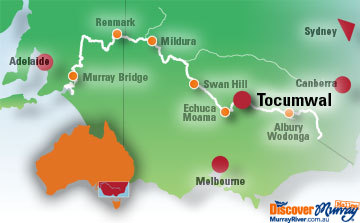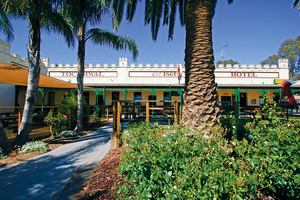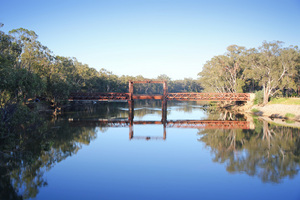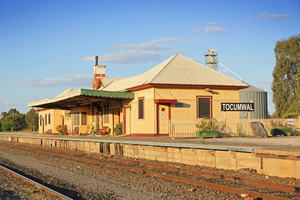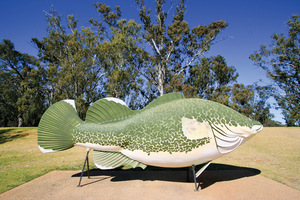
History of Tocumwal, New South Wales on the Murray River
It's generally accepted that Tocumwal (originally Tucumival) was named after an Aboriginal word meaning "deep hole" or "pit", and that it was the abode of a native spirit which was accustomed to flit from the river underground by a subterranean passage and bob up at the Blow Hole in the granite formation at the Rocks.
The "Blow Hole" in Tocumwal is the small outcrop of rocks which is near "The Rocks" area, north-east of Tocumwal and has been closely associated with the folklore of the area.
In the very early days a large English syndicate owned all the land in this district from somewhere near Deniliquin to Mulwala. As Patrick Hennessy settled on the Murray in 1840 and purchased a large area from Messrs. Huron and Lester in 1843 we think the English syndicate must have been broken up into smaller holdings before that date.
This was the first purchase by Patrick Hennessy and was probably east of Tocumwal, because at the time Murray Run Station (described later as containing 185 square miles and bounded on the west by the junction of the Tuppal Creek and Murray River) was controlled by the Royal Bank of Australia who sold it to James Moodie during the 1840s. Moodie sold it to Patrick Hennessy at the later date, we think about 1848, as Patrick Hennessy owned the Murray Run before he purchased Berrigagama (which adjoined Murray Run on the latter's western boundary in 1849).
This latter purchase was divided between Mr. Hennessy's sons, Edward, William and Robert. The latter two were still living in the district in 1896 and Mr. Whitehead was a grandson of Patrick Hennessy.
In the early 1850s a regular crossing place had been established somewhere in the vicinity of the town and it is thought the first buildings were built in or near the present town site about 1857 or 1858.
In 1890 the Victorian Government snagging boat "Melbourne" completed 3 months work in the area, 300 snags were removed from one quarter mile section of the Murray River. Tocumwal was also proclaimed under the Police Offences Act.
The Tocumwal Hotel was built in 1861 by Mr Hillson and it had what was called the Horse Works to pump water and was situated near the river. It was a large circular frame that the draught horse was harnessed to and the horse walked in circles turning the frame that pumped the water through the pipes to the hotel. It was a regular stopping point for Cobb & Co. coaches and the paddle steamers which traded along the Murray River.
The first trading bank opened in leased premises in 1893 was the Commercial Banking Company of Sydney. The first bank manager also started the first Progress Association. A new building was built in Deniliquin Street and the bank remained in this building until 1941 when it closed due to the war.
The original bridge crossing the Murray River at Tocumwal was officially opened on Easter Monday 1895 by J.H. Young the NSW Minister for Works and Sir Maurice O'Rorke. The bridge was originally built for vehicular traffic and had to be strengthened with the Victorian Rail line was brought into Tocumwal in 1908. On December 9th, 1987 the second bridge (The Edward Hillson Bridge) that's used today was officially opened.
After providing a crossing for 92 years the Old Tocumwal Bridge was closed due to decking damage to traffic however it is still used by trains carrying grain. Although it can still be seen today, the old bridge stands as a historic centrepiece symbolising the glory days of Tocumwal.
In 1901, Tuppal Woolshed was built with 72 stands and was the second largest and finest in Australia and covered 20,000 feet. In 1902 there were 207,515 sheep shorn yielding 3,244 bales and they marked 65,511 lambs.
Chinese population expands in Tocumwal area in the 1930s. The gold rush in Victoria, New South Wales and Queensland saw a large number of Chinese workers come to the country from Quandong Province in China. They were renowned for their honesty and hard work in the gold fields doing work the Europeans found too difficult.
Wherever they went, their ability to create market gardens ensured produce was available to the workers on the mine fields. When the gold rush ended large camps of the Chinese were hired as contract labourers to ring bark scrub on large Riverina properties between Corowa and Deniliquin.
In January, 1905 the Victorian Railway reached the Murray River at Tocumwal. Transfer of the railway line from Victorian side to the New South Wales side was considered. Discussions took place in June 1906 and Mr. G.F. Sugden offered 5 acres of land for the Railway Station. The Victorian Government agreed to the cost of laying the rails and strengthening the bridge.
The morning of 9th July 1908 saw the historic event of the first stock train with 24 trucks of sheep crossing the bridge. A passenger train followed later that afternoon. In December 1911 a daily train service to Tocumwal commenced. Tocumwal remained a Victorian station until 1941, when it was transferred to the New South Wales Railways. Due to the different guage sizes, NSW Railways set about extending the Tocumwal Station to become a major trans-shipping port with spur lines in both guages being laid to serve the increasing traffic, particularly the need of the military.
In 1957 both the Railway Departments employed nearly 80 men in Tocumwal. The Railway Station at Tocumwal was for many years cattle and sheep trucking yards, moving the stock from the Southern Riverina to saleyards at the now closed Newmarket Saleyards in Melbourne. The yards were also the scene of a large cattle selling centre during the 1940s and 50s. The Railway Museum is open by appointment. Contact the Tocumwal Visitor Information Centre on (03) 5874 2517.
McIntyre Field was established by the USAAF in January 1942 (in expectation of the Japanese invasion of Northern Australia) and handed over to the RAAF in November 1942. It was the largest aerodrome in the Southern Hemisphere at one stage. The base was named after Captain Patrick W. McIntyre who was killed in a bombardment airplane crash in Queensland on 5th June 1942.
The old gate and guardhouse from the original main brick entrance to the Airfield was moved after the RAAF left and can now be found at the rear entrance of the Tocumwal Golf Club in Golf Links Drive (continuation of Emily Street). At its height there were over 450 buildings including workshops, living quarters and storage sheds. Several of the old hangers can still be seen. Some of the runways have become roads servicing several farms.
A museum display of photographs, articles, books, model aircraft and memorabilia are on display at the Tocumwal Visitor Information Centre. A one hour presentation for groups can be arranged by appointment, telling the incredible story of the war years at Tocumwal Aerodrome.
Extending the airforce history you can take the WAAAF Creek Walk, a 1.6 kilometre walk just out of town on the Barooga Road. The involvement of women in military aviation began in 1941 with the creation of the Women's Auxilary Australian Air Force (WAAAF). The WAAAF was formed because the RAAF urgently needed telegraphists for signal duties, replacing men required for active service. Eventually WAAAF personnel served in more than 60 roles. At their peak, WAAAF numbers exceeded 27,000. Up to 400 women served at Tocumwal between 1943 and 1946.
The Big Cod at the Tocumwal Foreshore was commissioned in 1967 by the Ladies Auxiliary of the Tocumwal Chamber of Commerce at a cost of $4,000. It was to be the first 'Big' thing in Australia and was made of fibreglass mouldings and built by Duralite in Melbourne. As fibreglass was a new medium back then, the Big Banana was completed and erected first. The 'Fish' as it is known locally, was originally located at the old swimming pool in Murray Street in 1968, but was later moved to its present location on the Foreshore.
Tocumwal today
Nowadays, the Murray River at Tocumwal and the tradition of free bush camping and water based activities continues to attract generation after generation returning to enjoy the water skiing, canoeing, swimming, camping, caravanning, bush walking and the vast array of native wildlife including over 150 different bird species. Wildlife abounds and it is not unusual to see kangaroos and koalas, wedge tails and wallabies in their natural habitat.
Tocumwal and district offers some of the best quality accommodation on the Murray, with many motels or self contained units and great caravan parks with beautifully landscaped surrounds, pools, spas, tennis, or red gum forest. Visitors are attracted to Tocumwal because of its magnificent sandy beaches (with 24 located within 5 minutes east and west), all surrounded by some of the most impressive red gum forests on the Murray River.
For more information about Tocumwal visit murrayriver.com.au/tocumwal. Source : Murray River Book
Tell your friends you found this at murrayriver.com.au!
Copyright Discover Murray 2025. This site or any portion of this site must not be reproduced, duplicated, copied, sold, resold, or otherwise exploited for any commercial purpose that is not expressly permitted by DISCOVER MURRAY.






 Anh Do The Happiest Refugee Live!
Anh Do The Happiest Refugee Live! DREAMS FLEETWOOD MAC & STEVIE NICKS SHOW
DREAMS FLEETWOOD MAC & STEVIE NICKS SHOW A Celtic Christmas by A Taste Of Ireland
A Celtic Christmas by A Taste Of Ireland CREEDENCE CLEARWATER COLLECTIVE
CREEDENCE CLEARWATER COLLECTIVE The Royal Edinburgh Military Tattoo 2023 - Arts On Screen
The Royal Edinburgh Military Tattoo 2023 - Arts On Screen
